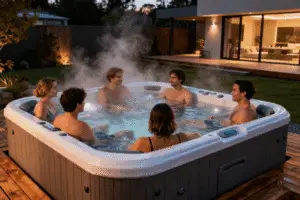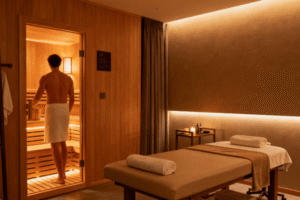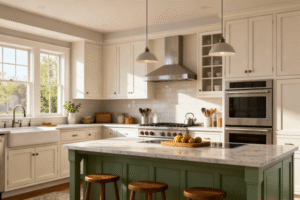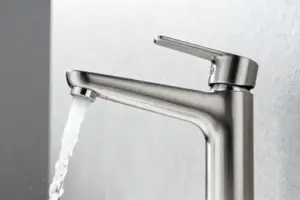
Are you dreaming of owning a spacious hot tub? Do you worry about the size, the cost, and the complexity of the installation? Many people feel confused before making this kind of purchase. I know these concerns are common among project buyers and wellness distributors.
A standard 6-person hot tub1 typically measures around 7 ft x 7 ft and holds approximately 350 to 500 gallons of water. Prices range from entry-level $5,000 to over $20,000 for luxury models. Running costs usually add about $30 to $100 to your monthly electricity bill, highly dependent on insulation quality.
Do not let uncertainty stop you from enjoying relaxation or from capitalizing on this profitable market segment. I have gathered all the key information for you to make a precise and informed decision for your projects.
Dimensions & Specifications: Can It Fit in My Yard?
The first question I hear people ask is always about space. A 6-person hot tub sounds huge. You absolutely need to know if it will fit perfectly in your outdoor area. I will give you the specific data points you need for precise planning.
Determining the dimensions and specifications2 of a 6-person hot tub is the crucial first step for installation. You must consider its footprint, the required water volume3, and its total weight. These figures will impact your site preparation and structural requirements, ensuring safety and compliance.

You need to look at these “standard” dimensions from a critical angle. A 6-person tub is not just a square or round container. Its design, including seating arrangement and shell thickness, will affect its final size. The choice of design impacts both comfort and the necessary footprint for installation. This means you must consider more than just the catalog size. You must factor in access points, service panels, and the necessary clearance for safety regulations in countries like Canada and the United States.
What Are the Exact Dimensions of a Standard 6-Person Hot Tub?
The word "standard" can be a bit misleading. Most 6-person hot tubs are designed to offer comfortable social space. You will typically see two main shapes: square and round. Square models are the most common, and they generally utilize space more efficiently.
- Square/Rectangular: Approximate Imperial Dimensions: 7 ft x 7 ft to 7.5 ft x 7.5 ft. Approximate Metric Dimensions: 2.13 m x 2.13 m to 2.28 m x 2.28 m. Typical Depth Range: 34 in to 38 in.
- Round: Approximate Imperial Dimensions: 7 ft to 8 ft diameter. Approximate Metric Dimensions: 2.13 m to 2.44 m diameter. Typical Depth Range: 36 in to 40 in.
You must factor in the operational space4 you need. The tub itself might only be 7 feet wide. However, you need extra space for the cover, steps, and for maintenance access. I always recommend leaving at least 3 feet (about 1 meter) of working space around the tub. This allows for easy entry and exit, and it provides convenience for future repairs. For example, if you were to install a large swimming spa from a supplier like Holie, which also offers sauna and steam room solutions, you would ensure adequate access for servicing the equipment panels. Do not just look at the tub's dimensions alone.
How Many Gallons of Water Does a 6-Seater Hot Tub Hold?
Water volume is a critical factor. It not only influences your water replacement frequency but also directly affects the tub's total weight5. A typical 6-seater tub requires a lot of water.
A 6-seater hot tub usually needs 350 gallons to 500 gallons of water. This range depends on the tub's depth and the specific seating configuration. Tubs with lounge seats generally require less water than those with all-seater configurations. When you evaluate suppliers, remember that higher water capacity might mean slightly higher running costs because you are heating more mass. However, a larger volume also often translates to better water circulation and less fluctuation in chemical levels.
What Is the Average Weight of a 6-Person Hot Tub (Dry vs. Filled)?
Weight is the single most important consideration for site preparation. You cannot underestimate the weight of a water-filled hot tub.
- Dry Weight: Approximately 700 lbs to 1,000 lbs (317 kg to 453 kg). This accounts for the shell, frame, and equipment.
- Filled Weight (Water + 6 Adults): 4,500 lbs to 6,000 lbs (2,041 kg to 2,721 kg). This is the crucial figure for foundation planning.
You absolutely must ensure your installation surface can handle this massive load. This is why, in the installation section, I emphasize the importance of a concrete foundation6. This weight is not something to take lightly. An inadequate foundation can lead to structural damage to the tub and potentially severe damage to your property. If you are sourcing for large hotels or resorts, the liability of improper installation due to underestimated weight is significant. I always advise my large company buyers to consult a structural engineer first, especially if the tub is going on an elevated deck or balcony. The complexity of moving a 6,000-pound object also requires pre-planning for delivery access, which is something a reliable supplier like Holie helps coordinate with detailed packing and shipping support.
Pricing & Operating Costs: Can I Afford It?
People always ask me, "How much does it really cost?" The initial purchase price of a hot tub is only part of the story. You have to consider the long-term operating expenses7. For B2B buyers like you, this means evaluating the Total Cost of Ownership8 (TCO).
The cost of a 6-person hot tub involves the initial purchase price, which varies significantly based on features and insulation. Operating costs are driven by your local electricity rates and the tub's energy efficiency9. High-quality tubs with better insulation cost more upfront but save money over time, ensuring lower TCO for your projects.
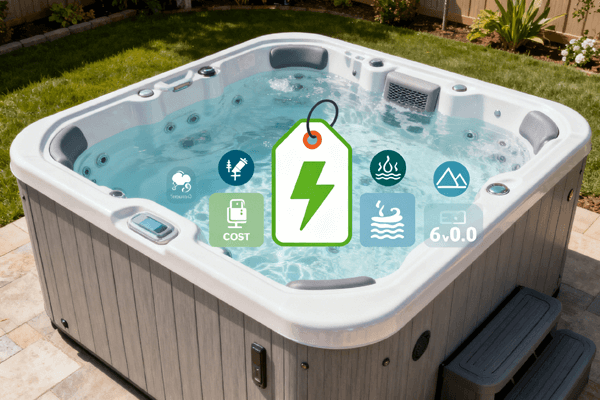
Do not let the sticker price fool you. The true cost of ownership is spread out over years. As a buyer, you must adopt a total cost of ownership perspective. A cheaper tub might seem like a good deal initially, but if it leaks heat like a sieve, your utility bills will soar. This is where buying from a quality-focused supplier like Holie pays off. They understand that top quality includes superior insulation and reliable components. When dealing with high volume sourcing, the warranty and after-sales support offered by the supplier become more valuable than the initial price discount. I focus on finding suppliers that minimize lifetime maintenance issues.
How Much Does a 6-Person Hot Tub Cost? (Entry vs. Luxury Models)
The price spectrum for a 6-person hot tub is wide. It is primarily dictated by the brand reputation, jet count, type of insulation, and integrated features (like LED lighting, sound systems, and Wi-Fi control).
- Entry-Level: Price Range $5,000 to $8,000. Features include perimeter foam or minimal insulation10, basic hydrotherapy, few jets, and a standard control system.
- Mid-Range: Price Range $8,000 to $15,000. Features include high-density foam or partial full-foam, better jet variety, ozone purification, and a digital control panel.
- Luxury/High-End: Price Range $15,000 to $25,000+. Features include full-foam insulation, advanced shell material, rare style options, multiple pumps, advanced filtration, and Wi-Fi smart control.
For a B2B buyer, the luxury end often involves features that matter to the end-user experience, such as superior hydrotherapy jets and enhanced durability. My own sourcing experience showed me that investing in mid-range to luxury models from reliable suppliers reduces warranty claims and increases customer satisfaction. Holie, a 15-year supplier, focuses on high quality and rare styles for OEM/ODM buyers. They offer competitive prices while maintaining the high insulation standards necessary for cold markets like Canada and Germany. This balance of quality and competitive pricing addresses a major need for company buyers like Giulia.
How Much Will a 6-Person Hot Tub Increase My Electricity Bill?
The running cost is the main worry for most buyers. The biggest variable here is insulation. A poorly insulated tub can easily cost twice as much to run.
A well-insulated 6-person hot tub can increase your monthly electricity bill by approximately $30 to $100 USD. This estimate depends on several key factors: Local Electricity Rate, Climate, Usage Frequency, and Cover Quality. To truly understand the impact, you must demand the supplier provide a power consumption estimate11 based on industry standards, such as the California Energy Commission (CEC) requirements. This data gives you an objective measure of the tub's thermal efficiency. I recommend only sourcing full-foam insulated models for markets with cold seasons, as the insulation difference significantly reduces the heating cycle runtime.
What Is the Cheapest Way to Run a 6-Person Hot Tub?
You can take simple steps to keep costs down. The key is to retain heat and reduce heating time.
- Use a High-Quality Cover: This is non-negotiable. A premium cover with a tight seal prevents 90% of heat loss.
- Maintain Consistent Temperature: Do not turn the heater off between uses. It costs more energy to constantly reheat the water than to maintain the temperature.
- Adjust Filtration Cycles: Run the pumps during off-peak electricity hours, if your utility offers time-of-use pricing.
- Wind Shelters: Placing the tub in a sheltered area reduces wind chill and heat loss.
Does a 6-Person Hot Tub Increase Home Value?
In some markets, yes, it can. A hot tub is seen as a luxury amenity12. While it may not always return $100 of its cost, a well-maintained, high-quality, and aesthetically pleasing hot tub can certainly make your property more attractive. It appeals to a buyer seeking a wellness lifestyle13 product. If you are selling to high-end resort developers14, a quality-focused wellness item like a Holie spa adds perceived value to the whole project. The value added is directly proportional to the perceived quality and modernity of the spa.
Installation & Site Preparation: How Do I Set It Up?
Proper installation is non-negotiable for safety and longevity. You cannot just put a 6,000 lb15 tub down anywhere. You need a solid foundation.
Installation requires careful site preparation, including establishing a level and structurally sound foundation to support the massive weight. You must also ensure dedicated, properly rated electrical wiring is installed by a qualified electrician to meet safety codes and ensure the full performance of the pumps and heater.
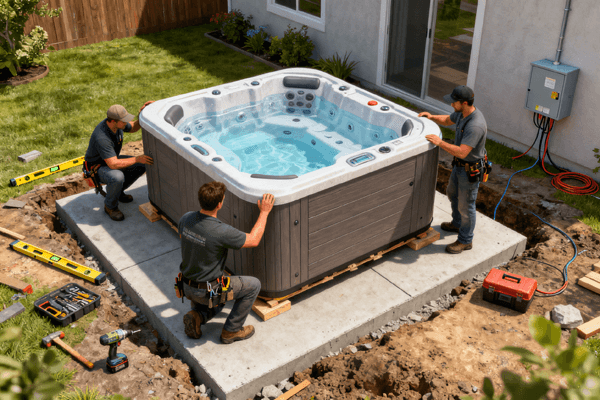
I have seen projects fail because the foundation was ignored. The weight of the filled tub will crack patios or sink into soft ground. This leads to costly repairs and potential voiding of the warranty. This is not just a problem for residential clients; for project buyers, foundation failure can mean massive project delays. You must treat the foundation as the most critical structural element. This requires careful planning for water drainage too. Water must drain away from the tub's base to prevent waterlogging the cabinet and damaging internal components, a common oversight in less experienced installations.
Do I Need a Concrete Slab for a 6-Person Hot Tub?
For a permanent 6-person hot tub, yes, you absolutely need a concrete slab16 or an engineered foundation. Remember that the total weight is over 2 tons. You need a foundation that is level, non-shifting, and rated to handle this load. Other acceptable options include reinforced decking or paving stones over compacted crushed rock, but concrete is the most reliable choice. Do not use grass or patio blocks set directly on soil. The pressure exerted on the ground by 6,000 lbs is significant. Placing it on grass will inevitably cause the ground to shift unevenly, stressing the tub's shell and frame, leading to costly leaks and premature component failure.
How Thick Should the Concrete Base Be?
For a standard 6-person tub, the concrete slab should be a minimum of 4 inches (10 cm) thick17.
The slab must be poured over a solid sub-base of crushed stone and should include steel reinforcement (rebar or wire mesh)18. This reinforcement prevents cracking and ensures the load is distributed evenly across the entire area. You also want to ensure the slab is slightly larger than the hot tub's footprint, allowing for the necessary surrounding space. Proper preparation includes a 4 inch compacted gravel base underneath the concrete slab. This gravel base allows for adequate drainage and helps prevent frost heave in colder climates, which is a major concern for buyers in Canada, like Giulia. You must also incorporate a slight slope (about 0.25 inch per foot) in the concrete away from the tub to facilitate water runoff during cleaning and maintenance.
What Are the Electrical Requirements for a 6-Person Spa?
The electrical requirements are strict and must be handled by a licensed professional.
Most 6-person hot tubs require a dedicated 240V/50-amp19 or 240V/60-amp circuit. This circuit must be protected by a GFCI (Ground Fault Circuit Interrupter)20 breaker installed near the tub for immediate safety shut-off. Never use extension cords. The high-amperage requirement is necessary to power the heater and multiple high-output massage pumps simultaneously. You must ensure the wiring distance does not cause a voltage drop. The distance between the spa and the GFCI disconnect box should follow local electrical codes, typically between 5 feet and 10 feet. This ensures both safe operation and compliance with rigorous safety standards like UL or CE, which are essential for international trade.
How Close Can a 6-Person Hot Tub Be to the House?
Local codes vary, but a good rule of thumb is to keep the tub at least 10 feet (3 meters)21 away from overhead power lines.
You should maintain a minimum distance of 3 to 5 feet (1 to 1.5 meters)22 from the house or any permanent structure. This distance provides adequate access for maintenance, meets safety requirements for electrical access, and prevents moisture damage to your home’s siding or foundation. In my experience, leaving the full 3 feet of access around all four sides allows for easier repair of components which are often accessed through side panels. This is crucial for avoiding inefficient communication with suppliers' sales reps during troubleshooting, a major pain point I have faced before.
Maintenance, Water Care & Longevity: Is It Hard to Keep?
Maintenance seems daunting, but a good routine makes it easy. Proper water care23 is essential for both your health and the longevity of the tub's components. This routine maintenance is what separates a long-lasting tub from one that fails after just a few years.
Maintaining a 6-person hot tub24 involves regularly testing and balancing the water chemistry, sanitizing with chlorine or bromine, and periodic drainage and cleaning. Consistent care extends the lifespan of the spa significantly, often allowing it to last 15 to 20 years, making it a reliable, long-term asset.
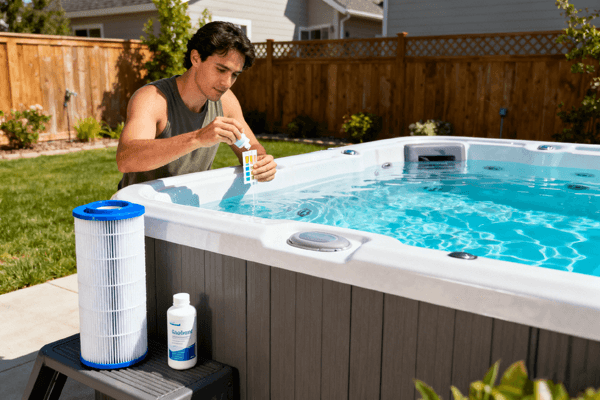
Good maintenance means being proactive, not reactive. You should establish a weekly routine for testing and adding chemicals. Ignoring water chemistry leads to cloudy water, damaged heaters, and ruined pumps. The biggest threat to the longevity of your tub is unbalanced water, which can corrode the heating element and cause damage to the jets and pump seals.
How Often Should You Change the Water in a 6-Person Hot Tub?
You should change the water in a 6-person hot tub approximately every 3 to 4 months.
The chemical total dissolved solids (TDS) and other contaminants build up over time, making it hard for sanitizers to work effectively. A simple calculation known as the "bather load factor" helps determine this. The rule of thumb is to divide the gallons of water by the average number of daily users. When this number drops below 50, a water change is necessary. For a 400-gallon tub used by two people daily, this works out to 200 days. However, given real-world factors, I advise clients to stick to a quarterly schedule. This ensures the best water quality and protects the equipment.
How Many Chlorine Tablets Does a 6-Seater Spa Need?
You do not typically use large chlorine tablets in a hot tub, as they dissolve too slowly and can create chemical imbalances25. Hot tubs use granular chlorine (Dichlor) or bromine.
The required dosage is based on keeping the free chlorine residual26 between 2.0 and 4.0 parts per million (ppm). For a 400-gallon tub, this usually means adding about 1 to 2 tablespoons of granular chlorine after each use or adding a small amount daily based on testing. Always test the water before adding chemicals. Using a floating dispenser or a chemical feeder is not the ideal approach for hot tubs; it is better to add dissolved granular sanitizer directly to the water. This ensures proper and immediate dispersion, protecting the internal components from chemical concentration damage.
Can I Put Baking Soda or Vinegar in My 6-Person Hot Tub?
Yes, you can use baking soda27 (sodium bicarbonate) in your hot tub, but only for a specific purpose: to raise the alkalinity. Do not use household vinegar.
- Baking Soda: Purpose is to increase Total Alkalinity28 (TA) and stabilize pH. Instructions: Dissolve slowly and add in small doses. Use commercial products if alkalinity is far off target.
- Vinegar: Not Recommended. Caution: Acidic nature can lower pH too quickly and damage shell/components. Use commercial pH Decreaser.
How Long Do 6-Person Hot Tubs Last?
A high-quality 6-person hot tub, properly maintained, should last between 15 and 20 years. The acrylic shell is designed to last the lifetime of the tub. The working components, like the heater, ozone generator, and pumps, are electromechanical and usually need replacement every 5 to 8 years, depending on usage and water chemistry. This longevity provides an excellent return on investment for resorts and property developers. When sourcing, look for suppliers like Holie who offer multi-year warranties on the shell and frame, as this is a strong indicator of top quality manufacturing.
How Often Should I Empty My 6-Person Hot Tub?
You should fully empty and refill your 6-person hot tub approximately 4 times per year, or every 3 months. This is to reset the water chemistry and perform a thorough clean of the shell and filters. This process is necessary because chemical solids build up, which is what we call Total Dissolved Solids29. Once the TDS level gets too high, the water becomes saturated and cloudy, making it impossible for sanitizers to work effectively, which is a major pain point for users.
Troubleshooting & Common FAQs
I have compiled the most common questions and issues I have encountered in the wellness industry. Knowing these answers helps you maintain confidence in your purchase and quickly address customer service issues.
How Long Does It Take to Heat a 6-Person Hot Tub30?
It takes a significant amount of time to heat the water from cold-fill to the desired temperature of 100°F to 104°F.31
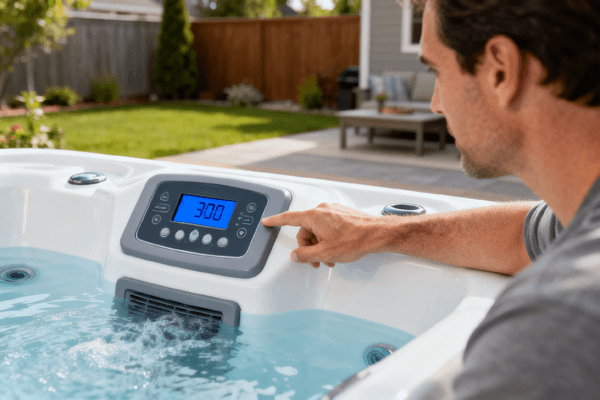
A typical 6-person tub with a 4 kW heater will heat the water at a rate of approximately 5°F to 8°F per hour. If you fill a cold tub at 50°F, it will take between 6 to 10 hours to reach a comfortable soaking temperature. This is why I stress the importance of a quality cover. A poor cover can add several hours to this heating time, especially in cold climates like Canada32.
Why Is My Hot Tub Pump Making Noise?
Pump noise is a common issue and can indicate a few things. You should check these points:
- Low Water Level33: Air gets sucked into the pump, causing a loud, gurgling noise. Add more water immediately.
- Clogged Filter34: A dirty filter restricts water flow, straining the pump motor and making it whine. Clean or replace the filter.
- Worn Bearings: If the noise is a constant grinding or squealing, the motor bearings are likely worn and the pump may need repair or replacement. This is usually due to long-term exposure to unbalanced water chemistry.
Can a Hot Tub Be Placed Directly on the Grass or Ground?
No, a hot tub cannot be placed directly on grass or bare ground.
The ground will shift, settle, and erode unevenly under the massive weight of the filled tub. This will put stress on the shell and frame, leading to cracks, leaks, and potential structural failure, which will void your warranty. You must use a solid, level, and prepared foundation, like a concrete slab or reinforced deck. Do not risk the entire installation with an inadequate base.
Conclusion
Choosing the right 6-person hot tub requires a comprehensive focus on dimensions, Total Cost of Ownership analysis, and meticulous installation planning. By selecting a supplier like Holie that ensures top quality insulation and reliable components, you can effectively manage utility expenses. Always prioritize a structurally sound foundation and adhere to a strict maintenance schedule to maximize your investment's longevity and ensure decades of hygienic enjoyment.
-
Explore this link to understand the benefits and specifications of a 6-person hot tub, helping you make an informed purchase. ↩
-
This resource will guide you through the essential dimensions and specifications needed for hot tub installation. ↩
-
Understanding water volume is crucial for maintenance; this link provides insights into typical water capacities. ↩
-
This resource explains the necessary operational space for safety and maintenance around hot tubs. ↩
-
Learn about the total weight implications for installation, ensuring your foundation can support it. ↩
-
Explore the importance of a concrete foundation to prevent structural damage and ensure safety. ↩
-
Explore this to grasp the full financial implications of owning a hot tub beyond the initial purchase. ↩
-
Understanding TCO helps you make informed purchasing decisions, ensuring long-term savings and efficiency. ↩
-
Learn how energy-efficient models can save you money on utility bills over time. ↩
-
Understanding insulation can help you choose a model that minimizes energy costs and maximizes comfort. ↩
-
Get insights on how to evaluate a hot tub's energy use to avoid unexpected costs. ↩
-
Find out how luxury amenities can increase property appeal and market value. ↩
-
Explore how hot tubs contribute to wellness, enhancing your quality of life and property value. ↩
-
Understanding developer needs can guide your purchasing decisions for maximum investment return. ↩
-
Understanding the weight of a hot tub is crucial for proper foundation planning and safety. ↩
-
A concrete slab provides a stable and durable foundation, essential for the longevity of your hot tub. ↩
-
Knowing the correct thickness ensures the slab can support the weight and prevent cracking. ↩
-
Steel reinforcement prevents cracking and ensures even weight distribution, enhancing durability. ↩
-
Understanding electrical requirements is vital for safe and efficient hot tub operation. ↩
-
A GFCI is crucial for preventing electrical hazards, ensuring safety during hot tub use. ↩
-
Maintaining proper distance from power lines is essential for safety and compliance with local codes. ↩
-
This distance is important to prevent moisture damage and ensure easy access for maintenance. ↩
-
Explore this resource to learn essential tips for maintaining water quality and ensuring a healthy hot tub experience. ↩
-
This link will provide valuable insights into the specific maintenance needs of 6-person hot tubs for optimal performance. ↩
-
This resource will help you identify and correct chemical imbalances to keep your hot tub safe and enjoyable. ↩
-
Understanding free chlorine levels is crucial for water safety; this resource will guide you on maintaining proper levels. ↩
-
Discover the benefits of using baking soda for alkalinity and pH stabilization in your hot tub. ↩
-
Learn about Total Alkalinity and its role in maintaining balanced water chemistry in your hot tub. ↩
-
Understanding TDS is key to maintaining water quality; this link will explain its impact on your hot tub. ↩
-
Explore this link to understand the heating process and factors affecting the time for a 6-person hot tub. ↩
-
Explore this link to understand the health benefits and safety guidelines for hot tub temperatures, ensuring a safe and enjoyable experience. ↩
-
Explore this resource to learn effective strategies for heating hot tubs efficiently in cold Canadian weather. ↩
-
Understanding the impact of low water levels can help you prevent pump noise and maintain your hot tub's health. ↩
-
Learning how to properly maintain your filter can enhance your hot tub's performance and extend its lifespan. ↩



